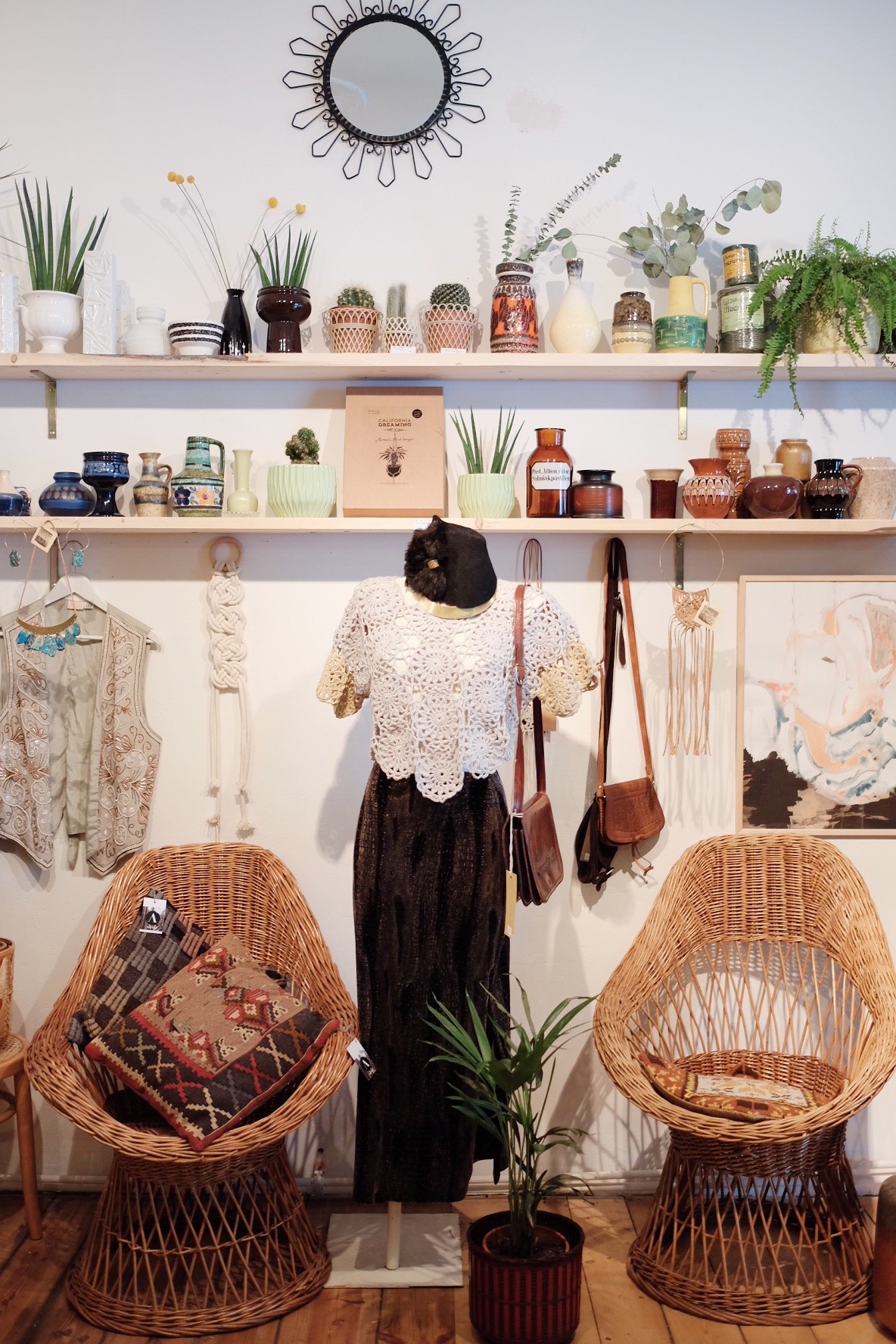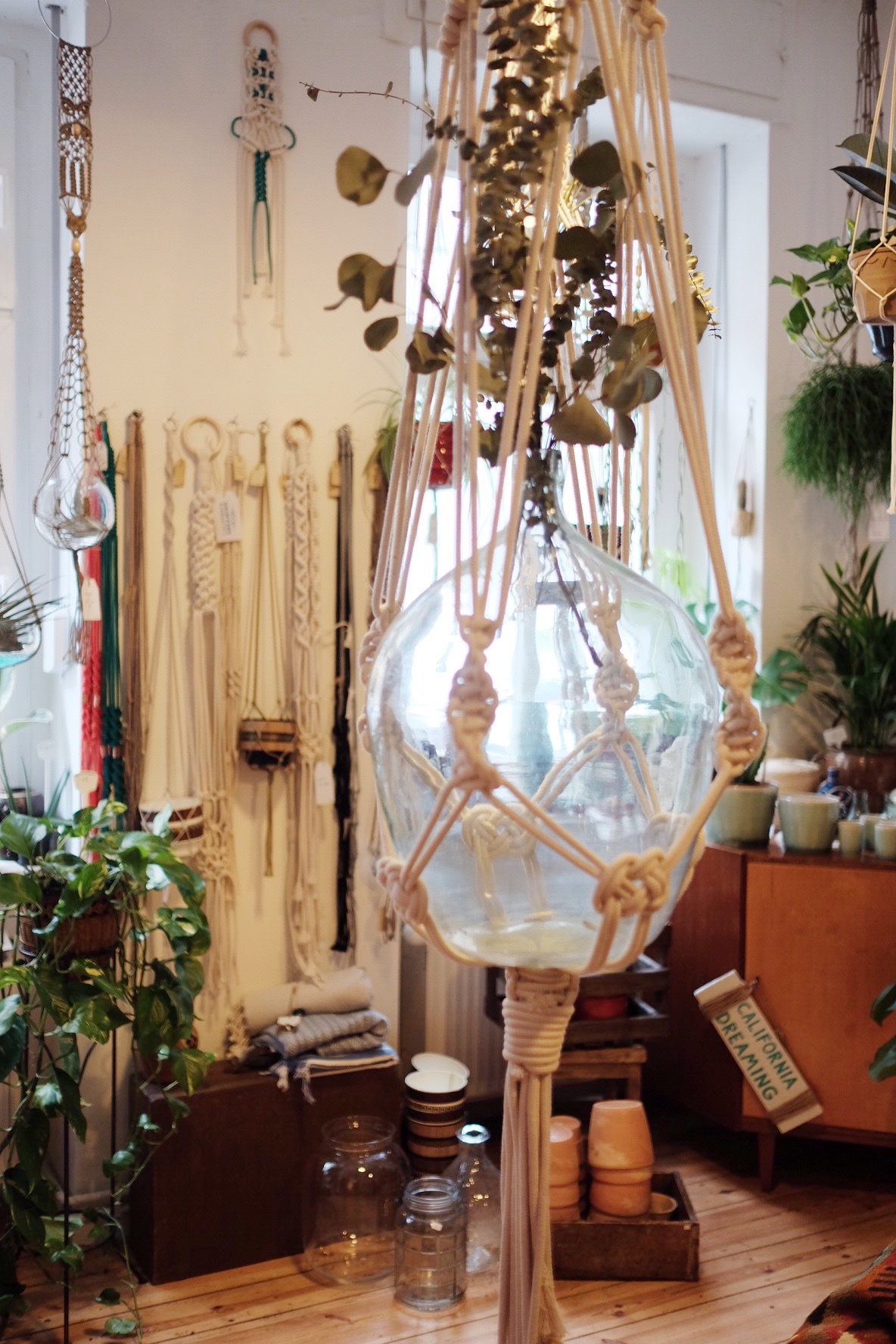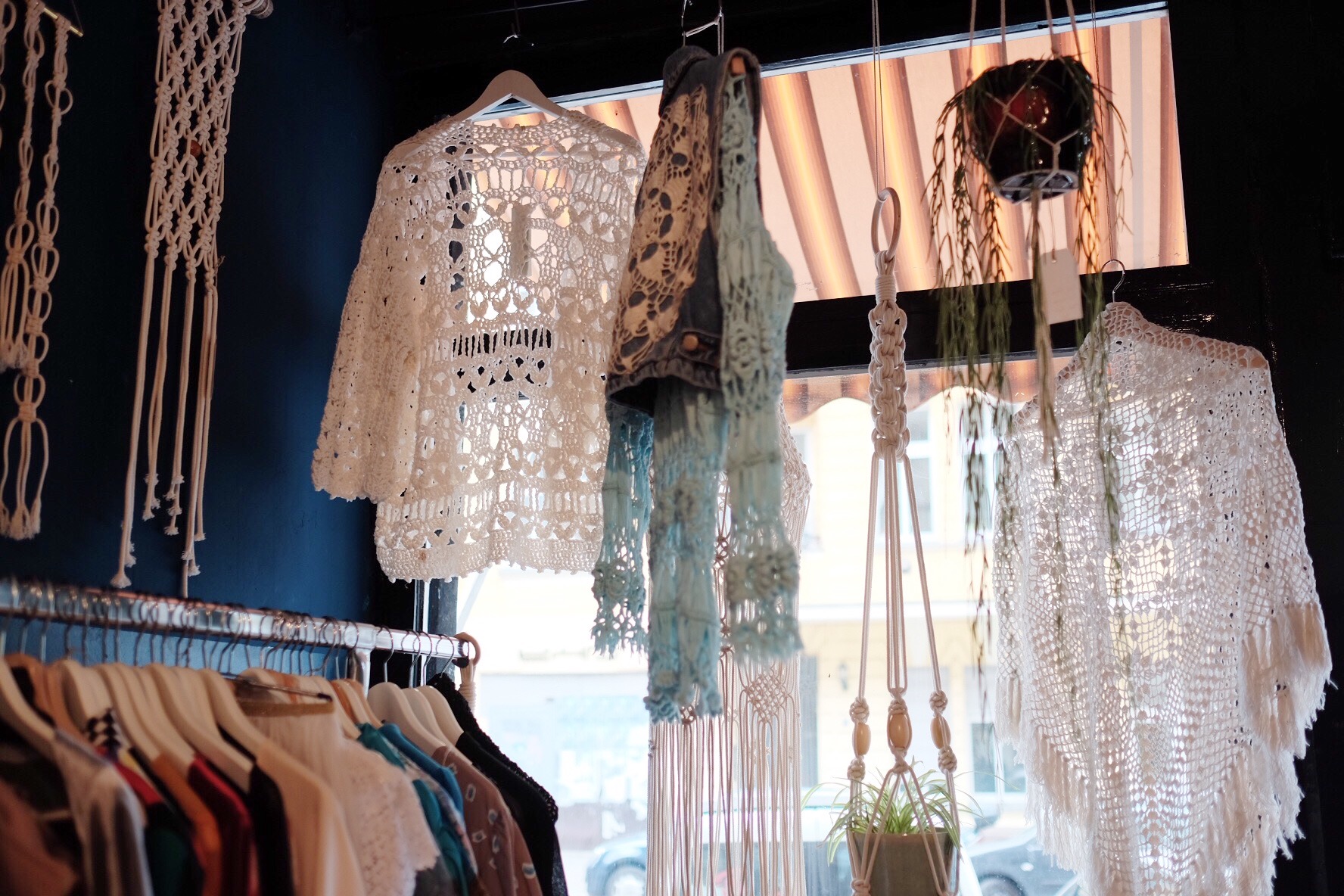Queen of Macramee - Dörte Bundt
I met Dörte about three years ago at VOODOO MARKET in Berlin. She was one of the designers that I was looking forward to the most. She is the owner of "California Dreaming", a macramé design label leading the renaissance of a long forgotten craft in Germany. I asked her a few questions and hope you enjoy reading more about why and how she found her passion for "artful knots" and how she got to live off her craft.
Dörte traf ich das erste Mal vor ungefähr drei Jahren auf dem VOODOO MARKET in Berlin. Sie war eine der Designer, auf die ich mich am meisten gefreut hatte. Sie ist die Besitzerin von "California Dreaming", dem Makramee Designlabel, welches die Renaissance eines lang vergessenen Handwerks in Deutschland anführt. I habe ihr ein paar Fragen stellen dürfen und hoffe ihr findet sie danach genauso toll, wie ich. Lest hier warum und wie sie ihre Leidenschaft für "kunstvolle Knoten" fand und wie sie sich damit selbstständig machte.
Do you remember the first time you had an encounter with macrame? Where was it? Please describe the situation. // Erinnerst du dich noch als du das erste Mal mit Makramee in Berührung kamst? Wo war das? Bitte beschreibe die Situation.
I vaguely remember seeing macramé in the GDR times, where I grew up. It was hanging in my grandparents’ apartment, or perhaps in an office setting I visited. Since this vague childhood recollection I had not seen any in real life until 2012, when Joel, my boyfriend from California, reminded me of it and pushed me to make some for our home. I followed the instructions from an old vintage magazine, which I had purchased through Etsy. That is when the addiction started, and California Dreaming was born :)
Ich erinnere mich vage daran, Macramee in der DDR zu sehen, wo ich aufgewachsen bin. Es hing in der Wohnung meiner Großeltern, oder vielleicht in einem Büro, das ich besuchte. Seit dieser vagen Kindheitserinnerung hatte ich bis 2012 kein wirkliches Makramee gesehen, bis Joel, mein Freund aus Kalifornien, mich daran erinnerte und mich dazu veranlasste, etwas für unsere Wohnung zu fertigen. Ich folgte den Anweisungen eines alten Vintage-Magazins, das ich auf Etsy gekauft hatte. Das war dann der beginn meiner "Sucht", und California Dreaming wurde geboren.
What exactly is Macrame and where does macrame come from? // Was genau ist Macrame und woher kommt es?
There are different opinions on the exact origin of macramé, but the most prominent one is that macramé is an Oriental craft and means as much as “embroidered veil” in Arabic. The word migramah, which macramé stems from, describes the fringes which where used to keep the flies away from camels. The craft was brought to Europe with the crusaders in the 13th century, and sailors have always used knotting as a means to pass time during long periods on the sea.
After gaining first popularity among women during the Victorian ages, it had a strong revival in the 1970s, when macramé could be found in houses from the Californian West Coast to the GDR.
Es gibt verschiedene Meinungen über die genaue Herkunft von Macramee, aber die prominenteste ist, dass Macramee ein orientalisches Handwerk ist und bedeutet so viel wie "bestickter Schleier" auf Arabisch. Das Wort Migramah, aus dem Macramee stammt, beschreibt die Fransen, womit man die Fliegen von Kamelen fernhielt. Das Handwerk wurde im 13. Jahrhundert mit den Kreuzfahrern nach Europa gebracht und die Seemänner haben immer das Knüpfen von Knoten genutzt, um die lange Zeit auf dem Meer zu verweilen.
Nachdem Makramee während der viktorianischen Zeit erste Beliebtheit bei Frauen gewonnen hatte, hatte sie in den 70er Jahren eine starke Wiederbelebung, als Macramee in Häusern von der kalifornischen Westküste bis zur DDR entdeckt werden konnte.
In how far is macramé different now from the 70s? // In wieweit ist Macrame heute anders als in den 70ern?
This is a very subjective view, but I don’t think macramé has arrived yet as it did in the 70s. While it used to be a household product, today it is still regarded as a niche trend and yes to solicit mainstream appeal. The range of products that can be made using macramé is endless and goes far beyond just plant hangers and wall hangings. 40 years ago it was not uncommon to wear clothes and accessories made of macramé, I think this can still be translated into a modern version. So far I have only seen it in the occasional haute couture collection, yet not in regular street wear.
Another difference is the type of material that is being worked with. While hemp, jute and other earthy coloured natural fibers gave macramé a quite rustic look in the 70s, today’s fibers like cotton or nylon give contemporary macramé a much more modern and clean look. I really love working with vintage fibers and I always pick up spools in thrift store whenever I find any, but sadly the organic types of rope that used to be made specifically for macramé are no longer being produced. I have recently found rope made in Germany in the 70’s with an original label calling it “Makrameeseil” (macramé rope), this shows how omnipresent it used to be.
Das ist eine sehr subjektive Sichtweise, aber ich glaube nicht, dass Macramee schon so wieder zurück ist, wie es in den 70er Jahren der Fall war. Während es früher ein Haushaltsprodukt war, gilt es heute noch als Nischen-Trend. Die Produktpalette, die mit Macramee hergestellt werden kann, ist endlos und geht weit über die Pflanzenhänge und Wandbehänge hinaus. Vor 40 Jahren war es nicht ungewöhnlich, Kleidung und Accessoires aus Macramee zu tragen, ich denke, das kann noch in eine moderne Version übersetzt werden. Bisher habe ich es nur gelegentlich in Haute Couture-Kollektionen gesehen, aber nicht in der regulären Streetwear.
Ein weiterer Unterschied ist die Art des Materials, mit dem man heute arbeitet. Während Hanf, Jute und andere erdig gefärbte Naturfasern in den 70er Jahren ein sehr rustikales Erscheinungsbild verliehen haben, verleihen die heutigen Fasern wie Baumwolle oder Nylon dem zeitgenössischen Macramee einen viel modernen und saubereren Look. Ich liebe es wirklich, mit Vintage-Fasern zu arbeiten, und ich kaufe gerne noch alte Originalfasern, wenn ich welche in Vintage- oder Flohmärkten finde aber leider werden die organischen Seilarten, die früher speziell für Macramee gemacht wurden, nicht mehr produziert. Ich habe vor kurzem ein Seil "Made in Germany" aus den 70er Jahren mit einem Original-Label namens "Makrameeseil" (Macramé Seil) entdeckt, dies zeigt, wie allgegenwärtig es früher war.
How would you describe your style? // Wie würdest du deinen Stil beschreiben?
I am always chasing after a few ideals. A simple elegance. I strive to create designs that espouse functionality with a laid back West Coast cool feeling.
Mein Herz schlägt immer nach eigenen Idealen. Eine einfache Eleganz. Ich bemühe mich, Entwürfe zu schaffen, die Funktionalität mit einem entspannten Westküsten-coolen Gefühl vermitteln.
You once said macrame is not a trend but a lifestyle. What do you mean by it? // Du hast mal gesagt, dass Macrame kein Trend sondern eine Lebensart ist. Was meinst du damit?
For me macramé suggests an earth friendly, simple, organic way of life that focuses on earthy materials and does not get caught up in chasing modern fickleness and exhausting oneself with what is new, expensive, and shiny. Again, for me, macramé offers an endless range of product making and does not stop with plant hangers and wall hangings.
Für mich schlägt Macramee eine erdfreundliche, einfache, organische Lebensart vor, die sich auf erdige Materialien konzentriert und sich nicht mit der Verfolgung moderner Unbeständigkeit beschäftigt - mit dem, was neu, teuer und glänzend ist. Auch für mich bietet Macramee eine unendliche Produktpalette und hört nicht mit Pflanzenhängern und Wandbehängen auf.
Did macrame change your life? // Würdest du sagen, dass Macrame dein Leben verändert hat?
Yes :) It gave me independence and the opportunity to live of something I love doing. I feel very lucky.
Ja :) Es gab mir Unabhängigkeit und die Möglichkeit, von etwas zu leben, was ich liebe. Ich bin sehr glücklich.
This is a "nicheart" how did you make this your profession? Wie bist du dazu gekommen dich mit dieser "Nischenkunst" selbstständig zu machen?
It was a long, scary process. In 2013 I started a small online shop on DaWanda, where I also used to work for three years. Until then macramé was just a hobby, but seeing that no macramé was available on the platform, I saw a huge potential. After about 1,5 years of working full time and running my online shop I finally gathered the courage to tell my boss that I want to quit my job. I was terrified, but I knew I had to do it. I often got up at 5am to make orders and brought them to the post office in my lunch break. After work I continued, and on weekends I would make new designs and take photos. I was only working.
It was a huge gamble to take this step, as I had no example to turn to. But having owned a jewellery design business in my previous life in Sydney, where I used to live for five years, it felt organic to run a creative business again.
Es war ein langer, beängstigender Prozess. Im Jahr 2013 habe ich einen kleinen Online-Shop auf DaWanda gestartet, wo ich auch drei Jahre lang arbeitete. Bis dahin war Macramee nur ein Hobby, aber da war kein Macramee auf der Plattform vorhanden, ich sah ein großes Potenzial. Nach etwa 1,5 Jahren in meinem Vollzeitjob und dem meines California Dreaming Online-Shops hatte ich endlich den Mut gesammelt, meinem Chef zu sagen, dass ich meinen Job beenden möchte. Ich hatte Angst, aber ich wusste, dass ich es tun musste. Ich bin oft um 5 Uhr aufgestanden, um Aufträge zu machen und sie der Mittagspause auszuliefern. Nach der Arbeit fuhr ich fort, und an Wochenenden machte ich neue Entwürfe und Fotos. Ich habe rund um die Uhr gearbeitet.
Es war ein riesiges Glücksspiel diesen Schritt zu machen, da es noch niemand anderen gab an dem ich mich hätte orientieren können. In meinem "früheren Leben" in Sydney (wo ich fünf Jahre lebte) hatte ich schon einmal ein Schmuck-Label. Daher fühlte es sich nicht fremd an, wieder ein kreatives Geschäft zu führen.
Do you have some advice for young creatives out there who struggle wether they should turn their passion into a profession?
Absolutely go for it. You have nothing to lose. Existential fear fuels creativity. The rewards are much higher than a safe paycheck.
Absolut reinhängen! Du hast nichts zu verlieren. Existenzielle Angst treibt Kreativität an. Die Belohnungen sind viel höher als ein sicherer Gehaltsscheck.


















